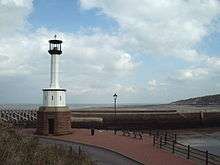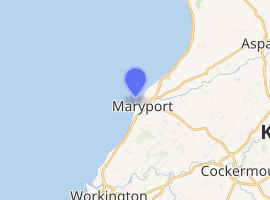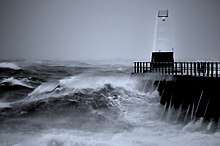Maryport Lighthouse
Maryport Lighthouse is a small lighthouse located in Maryport, Cumbria, England, formerly run by the UK's General Lighthouse Authority, Trinity House. It is a Grade II listed building.[3]
 Old Maryport Lighthouse | |
 Cumbria | |

| |
| Location | Maryport Cumbria England |
|---|---|
| Coordinates | 54.717773°N 3.510693°W |
| Year first constructed | 1796 (first) 1856 (second) |
| Year first lit | 1996 (current) |
| Deactivated | 1996 (second) |
| Foundation | 1-storey stone octagonal prism basement (second) |
| Construction | cast iron tower (second) aluminium tower (current) |
| Tower shape | two-stage octagonal tower with lantern (second) square tower with light (current) |
| Markings / pattern | unpaited basement, white tower, black lantern (second) white tower (current) |
| Tower height | 11 metres (36 ft) (second) 6 metres (20 ft) (current) |
| Focal height | 10 metres (33 ft) (current) |
| Light source | mains power |
| Characteristic | Fl W 15s. |
| Admiralty number | A4676 |
| NGA number | 4860 |
| ARLHS number | ENG-080 |
| Managing agent | Maryport Harbour and Marina [1][2] |
| Heritage | Grade II listed building |
18th century
Maryport is said to have possessed a small lighthouse in 1796; five years later Robert Stevenson described it in a report as an oil lamp with two reflectors.[4]
19th century
In 1833 an Act of Parliament granted permission for a dock to be built at Maryport together with a new pier and lighthouse. Construction was overseen by a new Board of Trustees and the pier, complete with its lighthouse, was in place by 1846.[5] Both remain in situ and the light is said to be the UK's oldest cast iron lighthouse (though it no longer serves as a navigation light).[6] It is 36 feet (11 m) high and consists of an octagonal metal plinth, column and lantern on top of a rusticated stone base.[3] It was originally gas-lit.[7]
Subsequently, the harbour continued to expand. In 1852, following a storm, the south pier (on which the lighthouse stands) was extended,[8] and a new light was provided at the end of the pier extension (described as a lantern on a post, lit by three gas jets) with a range of 6 nautical miles (11 km; 6.9 mi). The lighthouse thereafter served as a tidal light, being lit at night only for as long as there was 8 ft (2.4 m) of water within the harbour; (during the day it exhibited a red spherical day mark to signify the same).[7] In 1858 the Harbour Trustees commissioned James Chance to manufacture a small (fourth-order) fixed optic for the lighthouse,[9] which gave the tidal light a range of 12 nautical miles (22 km; 14 mi).[10] The previous year, following completion of the Elizabeth Dock, additional (minor) lights had been installed on the north tongue and south jetty, within the harbour, coloured green and red respectively.[7]
20th century
By 1946 the light was powered by acetylene. The painter L. S. Lowry used Maryport and the lighthouse in several of his paintings.[11] Trinity House took charge of it in 1961.
In 1996 Trinity House provided a new aluminium tower (54.7178°N 3.5107°W) for the end of the pier extension, lit by mains electricity.[4] At 4.7 metres tall and with a light intensity of only 120 candelas, the new tower was one of Trinity House's smaller beacons; it displays a flashing white light visible 6 nmi (6.9 mi) out to sea.
21st century
In 2010 Trinity House transferred responsibility for the new light to the Maryport Harbour Authority.[12] The old lighthouse was restored and repainted in 2017 as part of a government-funded initiative for the refurbishment of seaside towns.[13]
References
- Maryport The Lighthouse Directory. University of North Carolina at Chapel Hill. Retrieved 2 May 2016
- Mariport light Lighthouse Explorer. Retrieved 2 May 2016
- "The Lighthouse, The Harbour, Maryport, Cumbria". Historic England. Retrieved 25 February 2019.
- Woodman, Richard; Wilson, Jane (2002). The Lighthouses of Trinity House. Bradford-on-Avon, Wilts.: Thomas Reed. p. 244.
- Rennison, R. W. (1981). Civil Engineering Heritage: Northern England (2nd ed.). London: Thomas Telford Publishing. p. 114. ISBN 07277 2518 1.
- A page containing interesting facts about lighthouses worldwide Archived 13 November 2007 at the Wayback Machine
- "Lighthouse management : the report of the Royal Commissioners on Lights, Buoys, and Beacons, 1861, examined and refuted Vol. 2". p. 346.
- "Maryport Conservation Area Character Appraisal" (PDF). Allerdale Borough Council. Retrieved 1 June 2019.
- Chance, James Frederick (1902). The Lighthouse Work of Sir James Chance, Baronet (PDF). London: Smith, Elder & co. p. 166. Retrieved 24 February 2019.
- Davenport Adams, W. H. (1870). Lighthouses and Lightships: A Descriptive and Historical Account of Their Mode of Construction and Organization. London: T. Nelson & Sons. p. 303.
- A history of Maryport
- Trinity House annual report 2010 Archived 4 June 2013 at the Wayback Machine
- "Maryport Lighthouse restoration unveiled". ITV News. Retrieved 1 June 2019.
